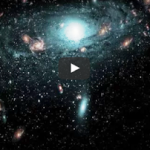Cosmic ‘barcode’ from distant galaxy confirms Nature’s constancy0
- From Around the Web, Space
- November 21, 2016
Astronomers have precisely measured the strength of a fundamental force of Nature in a galaxy seen eight billion years in the past.

A new series of photos and artists’ conceptions reveal in breathtaking detail the vicious world of galactic evolution, where spiral galaxies attract, shred, and assimilate nearby dwarf galaxies.

Researchers at the Atacama Large Millimeter/submillimeter Array (ALMA) announced that they had seen a water snow line in a young planetary disc for the first time, helped along by a heated outburst from the infant solar system’s star, V883 Orionis.

Using the Large Underground Xenon (LUX), scientists have discovered something about dark matter that brings up more questions than answers.

Scientists have discover a nearby galaxy that’s roughly the same mass as the Milky Way, but somehow contains fewer than 1 percent of its stars.

An international team of astronomers has created the largest ever three-dimensional map of distant galaxies in a bid to help them understand one of the most mysterious forces in the universe.

About 250 million light-years away, there’s a neighborhood of our universe that astronomers had considered quiet and unremarkable. But now, scientists have uncovered an enormous, bizarre galaxy possibly formed from the parts of other galaxies.

Fireworks shows are not just confined to Earth’s skies. NASA’s Hubble Space Telescope has captured a spectacular fireworks display in a small, nearby galaxy, which resembles a July 4th skyrocket.

Galaxies ‘waste’ large amounts of heavy elements generated by star formation by ejecting them up to a million light years away into their surrounding halos and deep space, according to a new study.